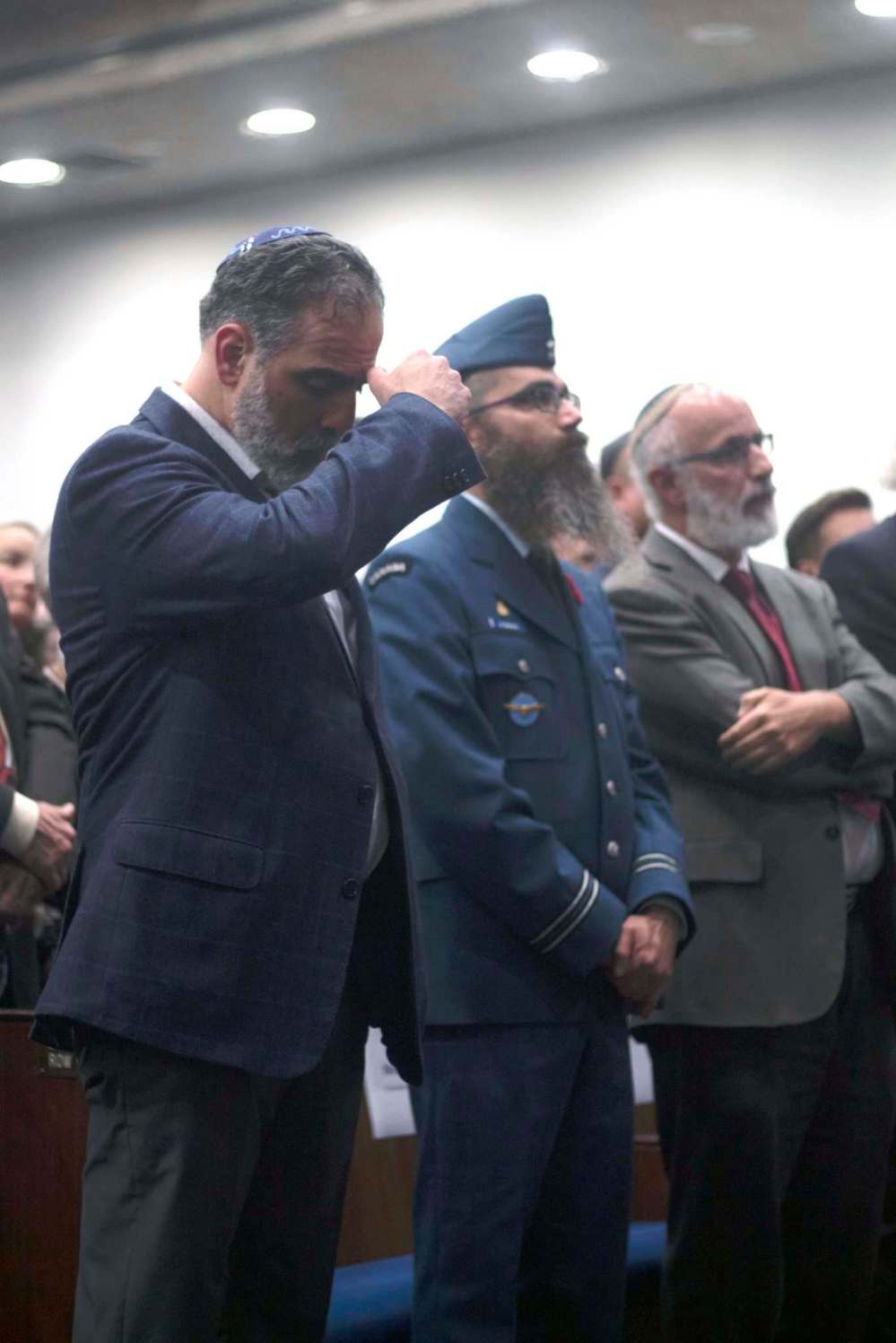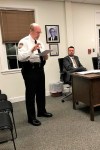Fighting extremism with education, compassion
Advertisement
Read this article for free:
or
Already have an account? Log in here »
To continue reading, please subscribe:
Monthly Digital Subscription
$1 per week for 24 weeks*
- Enjoy unlimited reading on winnipegfreepress.com
- Read the E-Edition, our digital replica newspaper
- Access News Break, our award-winning app
- Play interactive puzzles
*Billed as $4 plus GST every four weeks. Offer only available to new and qualified returning subscribers. Cancel any time.
Read unlimited articles for free today:
or
Already have an account? Log in here »
Hey there, time traveller!
This article was published 16/12/2018 (2270 days ago), so information in it may no longer be current.
A Shofar horn rings above hundreds of heads at Shaarey Zedek Synagogue — some in yarmulkes, some in turbans, some bare. Tears run down faces marked by grief as outside in the Winnipeg cold, police officers stand guard.
On Oct. 27, 11 people were gunned down at Tree of Life Synagogue in Pittsburgh, Pa. The shooting reverberated across the world for its brutality and senselessness, and for its location — a place of worship.
Winnipeggers from across the cultural spectrum gathered at Shaarey Zedek three days later in remembrance of the Pittsburgh victims, an act of solidarity and connection in the face of anti-Semitic violence and hatred.

“Seeing this tonight — I mean, they had to turn people away because it was a fire hazard. It’s pretty overwhelming,” Jewish Federation of Winnipeg president Laurel Malkin said after speaking at the vigil. “Since the shooting, the Jewish community has been inundated with (messages of support).”
Last year, B’nai Brith Canada recorded its second record-breaking year in a row for acts of anti-Semitism in Canada, with reported incidents of vandalism nearly doubling.
For the first time, Public Safety Canada listed right-wing extremism as a “growing concern” in its 2017 annual report. Winnipeg has not been entirely immune to far-right influence.
A board member of Winnipeg’s Belgian Club stepped down this summer after the club hosted a Canadian Nationalist Party meeting. The CNP is anti-immigration with a clear “Canada first” agenda. On its website, the CNP describes its political position as “nativist, protectionist and culturally traditional.”
Winnipeg’s Fascist Free Treaty One, a group working to seek out and disrupt white supremacy in Manitoba, protested the meeting, which attracted just three or four people.
Non-violent counter-protest is a viable option in combating extremism on the ground, says Tony McAleer, board chairman and former executive director of Life After Hate.
“I think it’s important to have competing events. If something’s coming in on Thursday night, have something bigger that expresses the community’s feelings,” McAleer said. “Try and pull people away.”
McAleer was once one of the most notorious white supremacist organizers in Canada. Today, his message is one of compassion and honest conversation.
“The hardest thing in the world to do is to have compassion for someone who has no compassion. But aren’t they the ones that need it the most?” he says.
Fascist Free Treaty One’s Omar Kinnarath says he agrees with McAleer’s suggestion for compassionate discourse.
“There always has to be chances; people get in these groups because they’re confused and looking for a sense of belonging,” he says.
Kinnarath says in the past several months, he and other members of the group have quietly been in contact with members of Proud Boys Manitoba, working to understand their reasoning and persuade them to step away from the movement.
The Proud Boys Manitoba Facebook page appeared in early 2018 as a subset of the Proud Boys — a far-right, men’s-only political group.
However, the page has since been removed following Facebook’s announcement they would ban all pages associated with the Proud Boys and its founder, Vice Media co-founder and alt-right figurehead Gavin McInnes.
When approached online for comment, a representative of Proud Boys Manitoba stated the group “(recognizes) that modern western culture is the best, and we get together regularly to celebrate that fact.”
The representative also stressed Proud Boys Manitoba does not associate with white supremacist groups like Soldiers of Odin, whose Manitoba subset has an active, violently anti-Islam Facebook account with nearly 160 followers.
Rather, the Proud Boys identify or have been identified as “alt-lite,” a movement associated with the alt-right that focuses on “western values” rather than race.
“You see that a lot now. They don’t talk about hate, they talk about pride in European culture,” former Heritage Front member Elisa Hategan says in a phone interview.
Hategan was only 16 when she joined the white supremacist group Heritage Front in the early 1990s after immigrating to Canada from Russia. She says this code-switching strategy isn’t limited to semantics. It’s a phenomenon she calls “the boots to the suits.”
“It’s shifting everything so you don’t recognize it right away, and it’s used to bypass your defence mechanisms,” she says.
McAleer says he’s no stranger to this strategy, having once employed it himself.
He recalls appearing on a talk show around 1989 dressed like a skinhead.
“By 1991, I was wearing a suit and tie. The process of mainstreaming had already begun,” he says.
And so, today’s white supremacist extremism often no longer looks how we expect it to.
According to research published by the Anti-Defamation League, this past year saw a 258 per cent increase in white supremacist activity on university campuses in the U.S., with 147 reported incidents in 2017 compared to 41 in 2016.
On Nov. 1 of this year, posters featuring the phrase “It’s Okay to be White” were posted on the University of Manitoba’s Fort Garry campus. The posters appeared to be part of a national campaign, having also been found in downtown Halifax.
School campuses may be regarded as fertile ground for recruitment by extremist groups, as they are able to court a more upwardly mobile population of potential followers.
“It’s kind of like (these kids are) bored, and they’re doing it because they’re stifled. And they’re joining this counterculture movement against the status quo,” Hategan says.
“So they have a more ideologically driven reason to become a neo-Nazi, basically.”
Hategan points to Montreal’s Centre for the Prevention of Radicalization Leading to Violence (CPRLV) as the future of anti-radicalization activism. Run by executive director Herman Deparice-Okomba, the centre has released research and data on the radicalization, both far-right and otherwise, of youth in schools for several years.
“They’re doing, to be honest with you, the best work in Canada,” she says. “Basically, the ages they’re targeting are 13 to 29 primarily, but they also have brochures and information for families. It’s sort of this whole integrated approach.”
The centre offers training programs in psychosocial intervention, education, and public safety that can be booked through the centre’s website. They’ve also released an online game in collaboration with the Quebec International Youth Offices called WediActivist. The game is designed to teach youth about hate speech and the limitations to freedom of expression.
Hategan says she is most excited about the recent release of Radicalishow 3, the third instalment in the Radicalishow comic book series following several characters on their path to radicalization. CPRLV has created an educator’s guide that outlines how best to explore the book’s themes with students.
It’s this youth- and education-oriented approach that Hategan says is the best long-term strategy for combating radicalization.
“It’s a lot easier to prevent kids from becoming damaged than to fix them when they’re broken. We really need to focus on prevention,” she says.


